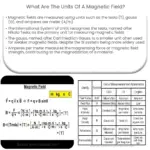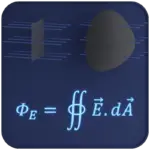Tesla – Unit of Magnetic Flux Density
Tesla (T) is the unit of magnetic flux density, also known as the magnetic field strength or simply the magnetic field. It is named after the Serbian-American scientist and inventor Nikola Tesla. One Tesla is defined as the magnetic field strength that produces one Weber (Wb) of magnetic flux through an area of one square meter (1 m²) perpendicular to the magnetic field.
1 Tesla (T) = 1 Weber per square meter (Wb/m²)
In the International System of Units (SI), the Tesla is the standard unit for measuring magnetic field strength. It is a derived unit, composed of the following base units:
1 T = 1 (kg·s⁻²·A⁻¹)
The Tesla is a relatively large unit of magnetic field strength. In practice, magnetic fields are often measured in smaller units like Gauss (G), where:
1 T = 10,000 Gauss (G)
In various applications, such as in MRI machines or strong research magnets, magnetic fields are typically measured in Tesla, while in everyday devices like fridge magnets or small electromagnets, fields are often measured in Gauss.
The equation to calculate the magnetic field strength in Tesla (T) depends on the specific scenario or magnetic field source. Here are some common examples:
- Straight current-carrying wire: The magnetic field (B) at a perpendicular distance (r) from a straight wire carrying current (I) is given by:B = (μ₀I) / (2πr)
- Center of a circular current loop: The magnetic field (B) at the center of a circular loop with radius (R) carrying current (I) is given by:B = (μ₀I) / (2R)
- Inside a solenoid: The magnetic field (B) inside an ideal solenoid with n turns per unit length carrying current (I) is:B = μ₀nI
- Inside a toroid: The magnetic field (B) inside an ideal toroid with N total turns, radius (R), and carrying current (I) is:B = (μ₀NI) / (2πR)
In these equations, μ₀ (4π × 10⁻⁷ T·m/A) is the permeability of free space, and the resulting magnetic field strength (B) is expressed in Tesla (T). These formulas apply to specific situations and can serve as a starting point for calculating magnetic fields in various scenarios.
Magnetic Fields
Magnetic fields are generated by moving electric charges (electric currents) and by the intrinsic magnetic properties of certain materials, such as ferromagnetic materials (e.g., iron, cobalt, and nickel). The behavior of magnetic fields is described by a set of mathematical equations called Maxwell’s equations, which also encompass electric fields.
Magnetic fields play a crucial role in various natural and technological phenomena, including the Earth’s magnetic field (geomagnetism), which protects the planet from solar radiation, the operation of electric motors, generators, and transformers, as well as data storage devices such as hard drives.
Permeability is a material property that quantifies its ability to support a magnetic field. High permeability materials, like iron, concentrate magnetic fields, while low permeability materials, like air, weakly support them. Permeability influences magnetic induction and is essential in designing magnetic circuits, transformers, and electromagnets, allowing efficient transfer or control of magnetic fields.
Examples of Magnetic Fields
Here are four examples of magnetic fields and their approximate strengths in Tesla (T):
- Earth’s magnetic field: The Earth’s magnetic field is relatively weak, with a strength of approximately 25 to 65 microteslas (µT), or 0.000025 to 0.000065 T, depending on the location. It is stronger near the poles and weaker near the equator.
- Refrigerator magnet: A typical refrigerator magnet has a magnetic field strength of about 0.001 T or 1 millitesla (mT). These magnets are strong enough to hold paper or thin objects to a metallic surface but are still relatively weak compared to other magnets.
- Medical MRI (Magnetic Resonance Imaging) machine: MRI machines use strong magnetic fields to generate detailed images of the body’s internal structures. The magnetic field strength of an MRI machine typically ranges from 1.5 T to 3 T, although some research and ultra-high-field MRI machines can generate fields of 7 T or higher.
- Neodymium (NdFeB) magnet: Neodymium magnets are powerful permanent magnets made from an alloy of neodymium, iron, and boron. These magnets can produce magnetic fields with strengths of up to 1.4 T or more, depending on the magnet’s size and grade.




